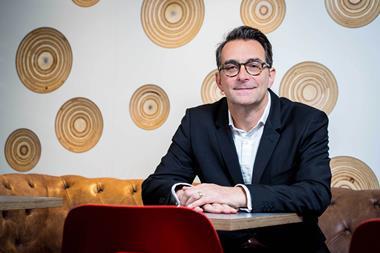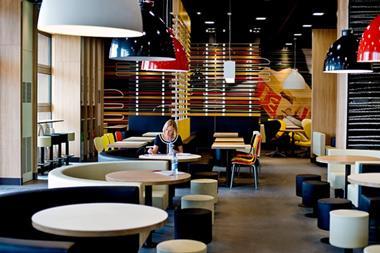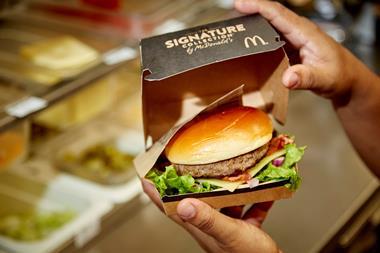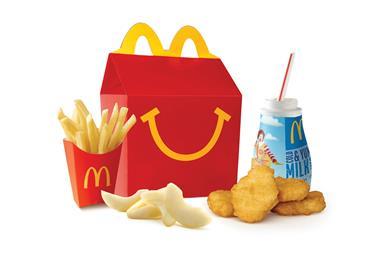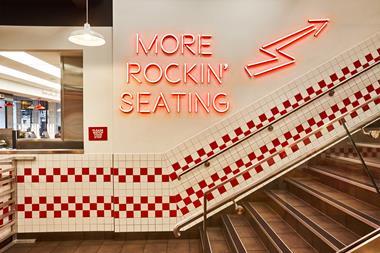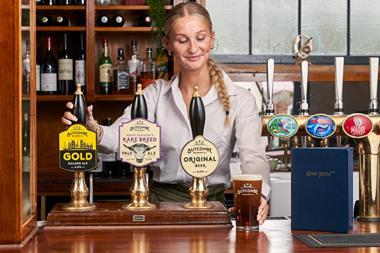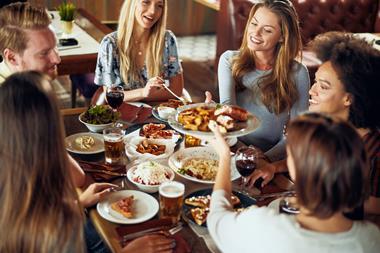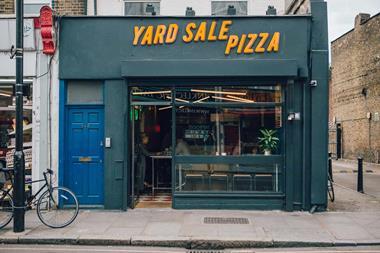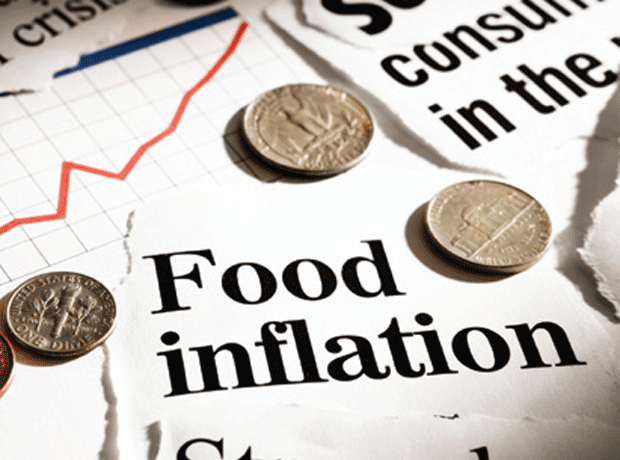Self-order screens and bluetooth locators are soon to become the norm at McDonald’s as it rolls out its Experience the Future programme. Georgi Gyton finds out what’s been behind the development of the programme, which was awarded the Best Use of Technology gong at this year’s Retailers’ Retailer awards.
McDonald’s is a brand that needs no real introduction – but its continued success in the face of a changing fast-food market in the UK bears closer examination.
Its success at this year’s Retailers’ Retailer of the Year awards ceremony came in the technology category but, according to Jason Clark, senior vice-president, chief operations officer at McDonald’s UK & Ireland, it all begins with listening to the customers, and the incremental changes that can improve their experience.
The UK & Ireland business currently totals 1,370 restaurants, and employs 122,000 people. It has achieved 49 consecutive quarters of sales growth and guest count increases, against the same challenging economic backdrop as every other restaurant business, and continues to push forward with developments – which, with an estate that size, is arguably no easy feat.
It is currently more than 80% of the way through its Experience of the Future project, which involves an overhaul of internal processes, design and technology, from the front to the back doors, at every one of its shops. It encompasses everything from the refurbishment of the dining areas, the installation of self-order touch screens and mobile phone charging points, to changing the structure and workflow of its kitchens. It has even installed twin-lane drive-thrus as part of the programme, in response to customer demand for convenience.
The investment in Experience of the Future has been sizeable. While Clark won’t be drawn on an exact figure, it is in the multimillions, he says.
“We work very closely with our franchisees, of which we have just over 190, and between us we have invested very heavily in the business to make sure we are doing the right things,” says Clark. This has been achieved by listening, he explains – listening to customers and staff to make sure it is funnelling its efforts, and money, into the right areas. Based on growth so far, and the response of customers, the changes have gone down incredibly well, he says.
Witnessing evolution
Clark has worked at the business for just shy of 30 years, and began his career on the front counter of a McDonald’s, so has witnessed first-hand the business’ evolution over the years. “Seeing how much change Experience of the Future has brought to our restaurant business has been very impressive,” he says, “and tech has been right at the centre of all those changes”.
The programme has been shaped by a significant amount of research and consideration of what has been happening in the industry in terms of technological developments, as well as expectations from customers and their changing shopping and spending habits. “We wanted to get the customers’ view of what they wanted from McDonald’s, and what was the right approach for us to take,” he explains. “Customers were pretty clear they didn’t want a completely different McDonald’s, but they did want us to be better than we were, so we set about looking at what we could do to enhance the customer experience.”
Many of the improvements made have been all about offering the customer more choice. Cue self-order screens, and the ability to select table service – which is available at the majority of its Experience of the Future stores. In addition, it is now rolling out bluetooth locators in stores where it offers table service, in order to cut down on time spent looking for customers.
“Knowing customers’ expectations around speed and convenience is very important,” says Clark. “So when we are making changes to our restaurants, for example changing the kitchen layout and structure, we have to make sure we continue to provide the same quality and speed of service to customers. If we are doing things that are slowing us down, then that’s not a good place to be in.”
He says the impact of the programme and feedback from both customers and employees has been very positive. “We have seen customers spending more time browsing the menu and looking at all of the options available on the touchscreens,” he says. “They have also been buying things they wouldn’t normally buy.”
Clark says a lot of the changes to spending habits have been positive from a health point of view. “We have a lot more customers choosing a side salad instead of fries, for example, or a bottle of water instead of a carbonated drink,” he says. Since the introduction of self-order screens, McDonald’s has also sold around 1.4 million extra fruit bags with children’s Happy Meals, than previously. “So we are seeing some really good behavioural changes where we have been able to nudge customers in the right direction,” he adds.
Better visibility
Other changes include the introduction of menu bundles. McDonald’s launched its Meals Under range last December, which groups items together that are under 400 or 600 calories. “It is not a new ‘lighter’ range, but it’s another example of us being able to offer better visibility of our range and additional options,” he says.
An enhanced focus on the customer has been the driving force behind a lot of the development work. Clark says this means the business is spending more time on the hospitality side of things, with the introduction of things like table service, delivery, and its mobile app. “In any kind of restaurant business you can get too focused on areas of process so, for us, making sure we are looking after customers and spending more time on the customer experience is really important,” he says.
Employees have also welcomed the changes, he says, in particular the move to enable more of its staff to work front-of-house. “We are a business that is very close to its customers – we serve 3.7 million a day across all of our restaurants – so to give more of our people the opportunity to work more closely with customers has been very rewarding for them,” says Clark.
The growth of the business has seen 5,000 new jobs created over the past couple of years, and Clark says it has committed to hiring 1,000 additional managers over the next 12 months, many of whom will come from within. Says Clark: “People is a big area of focus for us, both from the perspective of employment opportunities, and customer experience.”
The next big thing
Delivery is also an increasing part of the UK business, and is now available at more than 450 of its restaurants through Uber Eats – making up c8% of total sales at these restaurants. “We’re a year in with Uber Eats and it’s going incredibly well,” said Clark, with the service having clocked up somewhere in the region of one million unique users to date. “It is clearly a big market and a lot of people are interested in how brands are going to move on with delivery,” he says. “For us, it is part and parcel of helping to contribute to the customer experience. It’s good from a sales point of view, and it’s a growing part of our business,” he said.
So with delivery now an established part of the business, what else is on Clark’s radar in terms of trends? “The trend for vegetarian and vegan food is something that I, personally, want to make sure I keep an eye on, but it may not be for us yet,” he says.
Coffee is a big area of development for them however, with the business announcing in its Q2 trading update last month that it has been a big driver of sales, with coffee drinkers its most frequent customers.
In order to keep pace with changing customer expectations McDonald’s has been trialling barista-made coffee in some of its London outlets, and it will soon be expanding its trial to restaurants in the East Midlands.
But it is around technology where a lot of future developments are likely to come. “Technology is really exciting. I look at the way people are using their phones from a social media point of view; then you’ve got online ordering and delivery and apps for payment.
I think it’s fascinating how you interpret that and use that technology in a bricks and mortar business,” says Clark. “We recently launched an app, across our Experience the Future restaurants, and it’s something we want to build on over the coming years. The same with delivery. Technology enables customers to have more choice and more convenience, and it’s something that I get really excited about.”
He adds that drones are “one for us to keep an eye on”, but admits McDonald’s is unlikely to be first out of the blocks on that one. “I look at some of the robots being used and the way things are moving with autonomous cars… you have got to be involved or at least keeping an eye on what’s happening. I try to keep close to what’s interesting customers to make sure McDonald’s can keep relevant to that.”
Clark says one thing that is true of both hospitality and retail is that customers vote with their feet. “The response we are seeing so far from Experience of the Future is really very positive, but that doesn’t mean we will rest on our laurels,” he says. “We need to keep providing information to our customers and hopefully Experience of the Future will continue to help us make progress.” So far, if customers are voting with their feet at McDonald’s, they are walking in.

























